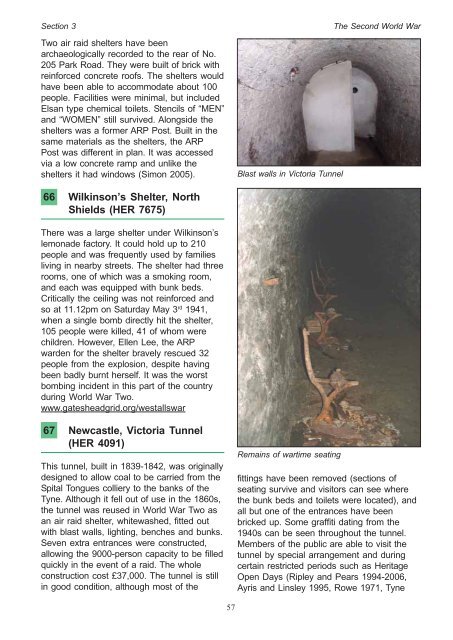TWENTIETH CENTURY DEFENCE SITES of TYNE and WEAR
TWENTIETH CENTURY DEFENCE SITES of TYNE and WEAR
TWENTIETH CENTURY DEFENCE SITES of TYNE and WEAR
You also want an ePaper? Increase the reach of your titles
YUMPU automatically turns print PDFs into web optimized ePapers that Google loves.
Section 3 The Second World War<br />
Two air raid shelters have been<br />
archaeologically recorded to the rear <strong>of</strong> No.<br />
205 Park Road. They were built <strong>of</strong> brick with<br />
reinforced concrete ro<strong>of</strong>s. The shelters would<br />
have been able to accommodate about 100<br />
people. Facilities were minimal, but included<br />
Elsan type chemical toilets. Stencils <strong>of</strong> “MEN”<br />
<strong>and</strong> “WOMEN” still survived. Alongside the<br />
shelters was a former ARP Post. Built in the<br />
same materials as the shelters, the ARP<br />
Post was different in plan. It was accessed<br />
via a low concrete ramp <strong>and</strong> unlike the<br />
shelters it had windows (Simon 2005).<br />
66 Wilkinson’s Shelter, North<br />
Shields (HER 7675)<br />
There was a large shelter under Wilkinson’s<br />
lemonade factory. It could hold up to 210<br />
people <strong>and</strong> was frequently used by families<br />
living in nearby streets. The shelter had three<br />
rooms, one <strong>of</strong> which was a smoking room,<br />
<strong>and</strong> each was equipped with bunk beds.<br />
Critically the ceiling was not reinforced <strong>and</strong><br />
so at 11.12pm on Saturday May 3 rd 1941,<br />
when a single bomb directly hit the shelter,<br />
105 people were killed, 41 <strong>of</strong> whom were<br />
children. However, Ellen Lee, the ARP<br />
warden for the shelter bravely rescued 32<br />
people from the explosion, despite having<br />
been badly burnt herself. It was the worst<br />
bombing incident in this part <strong>of</strong> the country<br />
during World War Two.<br />
www.gatesheadgrid.org/westallswar<br />
67 Newcastle, Victoria Tunnel<br />
(HER 4091)<br />
This tunnel, built in 1839-1842, was originally<br />
designed to allow coal to be carried from the<br />
Spital Tongues colliery to the banks <strong>of</strong> the<br />
Tyne. Although it fell out <strong>of</strong> use in the 1860s,<br />
the tunnel was reused in World War Two as<br />
an air raid shelter, whitewashed, fitted out<br />
with blast walls, lighting, benches <strong>and</strong> bunks.<br />
Seven extra entrances were constructed,<br />
allowing the 9000-person capacity to be filled<br />
quickly in the event <strong>of</strong> a raid. The whole<br />
construction cost £37,000. The tunnel is still<br />
in good condition, although most <strong>of</strong> the<br />
57<br />
Blast walls in Victoria Tunnel<br />
Remains <strong>of</strong> wartime seating<br />
fittings have been removed (sections <strong>of</strong><br />
seating survive <strong>and</strong> visitors can see where<br />
the bunk beds <strong>and</strong> toilets were located), <strong>and</strong><br />
all but one <strong>of</strong> the entrances have been<br />
bricked up. Some graffiti dating from the<br />
1940s can be seen throughout the tunnel.<br />
Members <strong>of</strong> the public are able to visit the<br />
tunnel by special arrangement <strong>and</strong> during<br />
certain restricted periods such as Heritage<br />
Open Days (Ripley <strong>and</strong> Pears 1994-2006,<br />
Ayris <strong>and</strong> Linsley 1995, Rowe 1971, Tyne

















